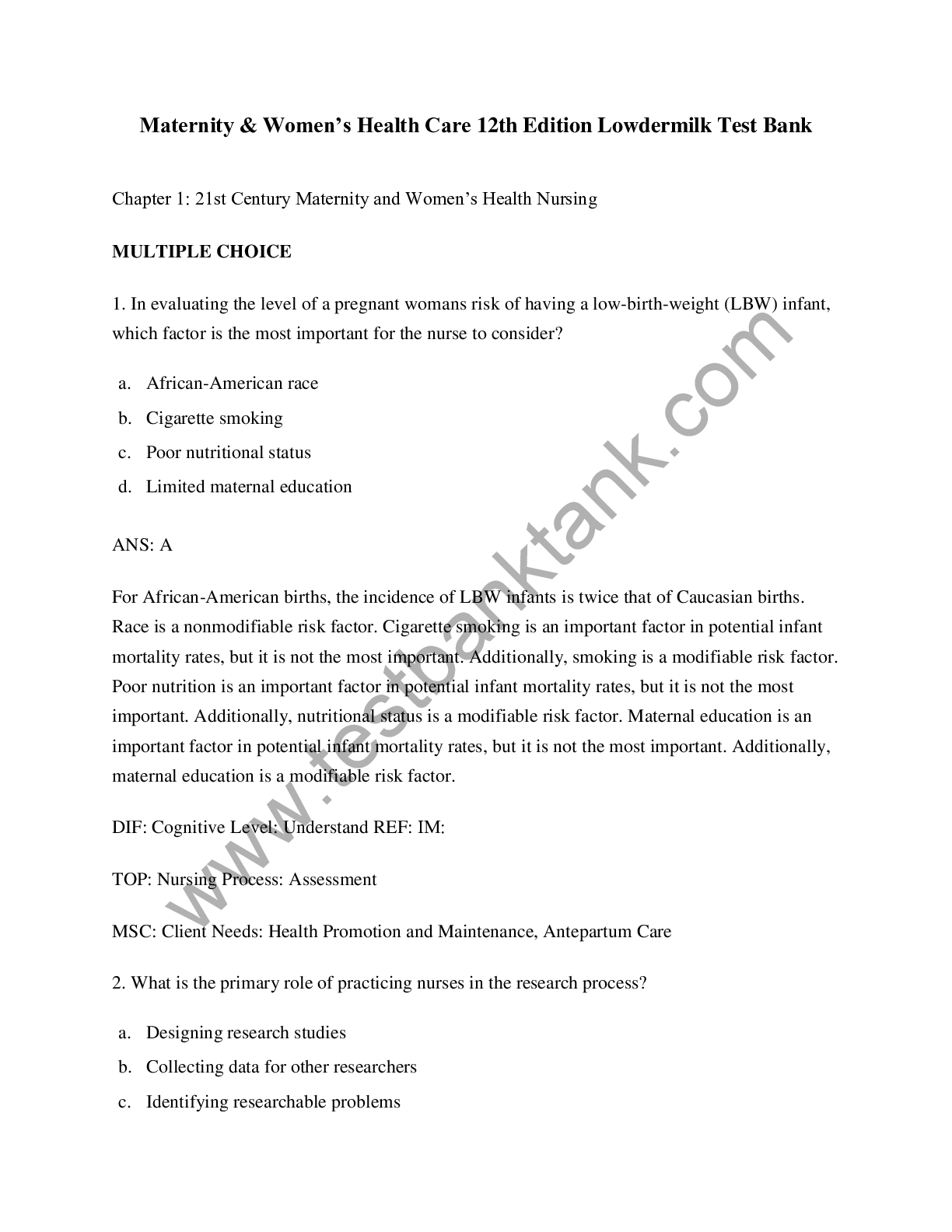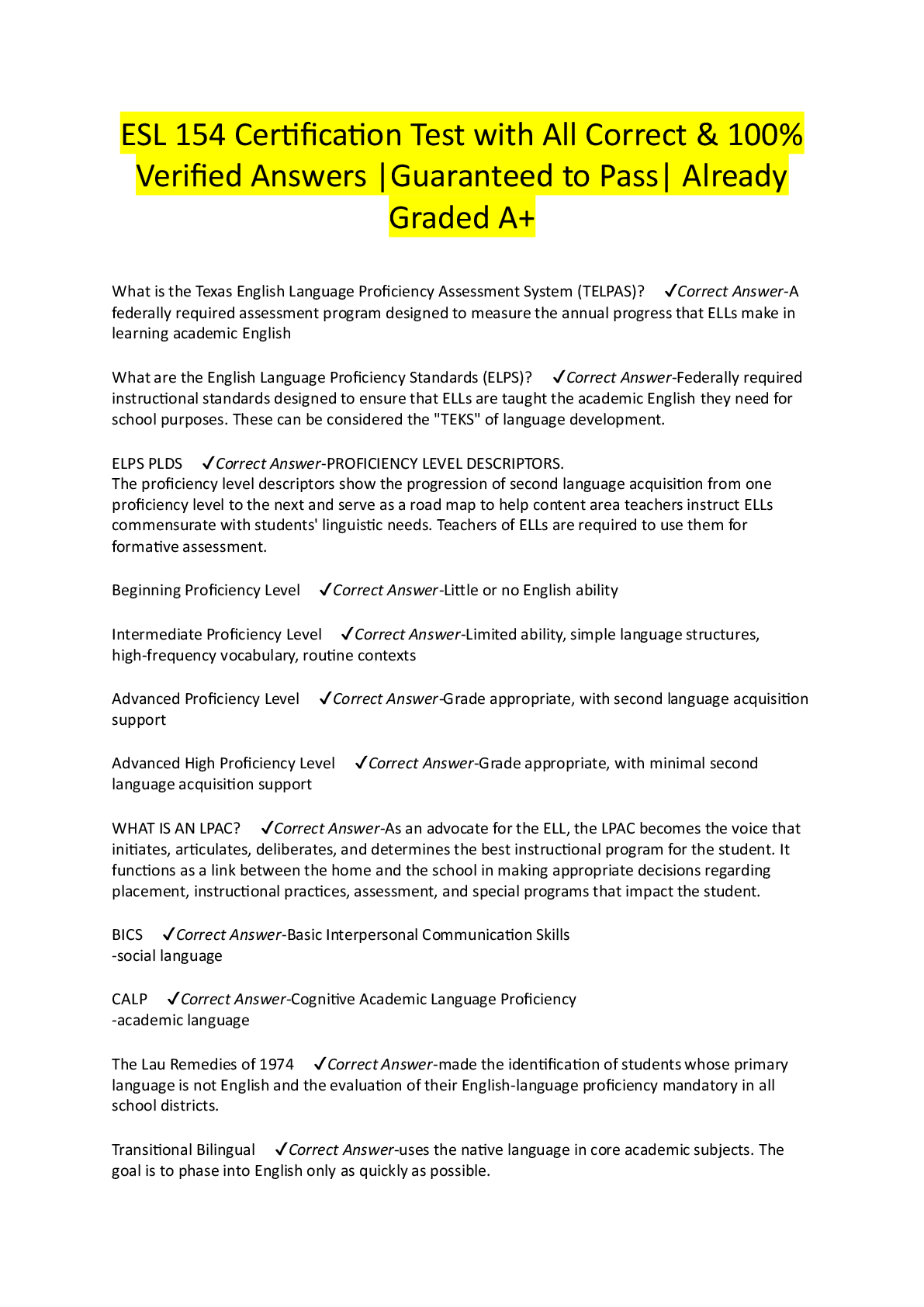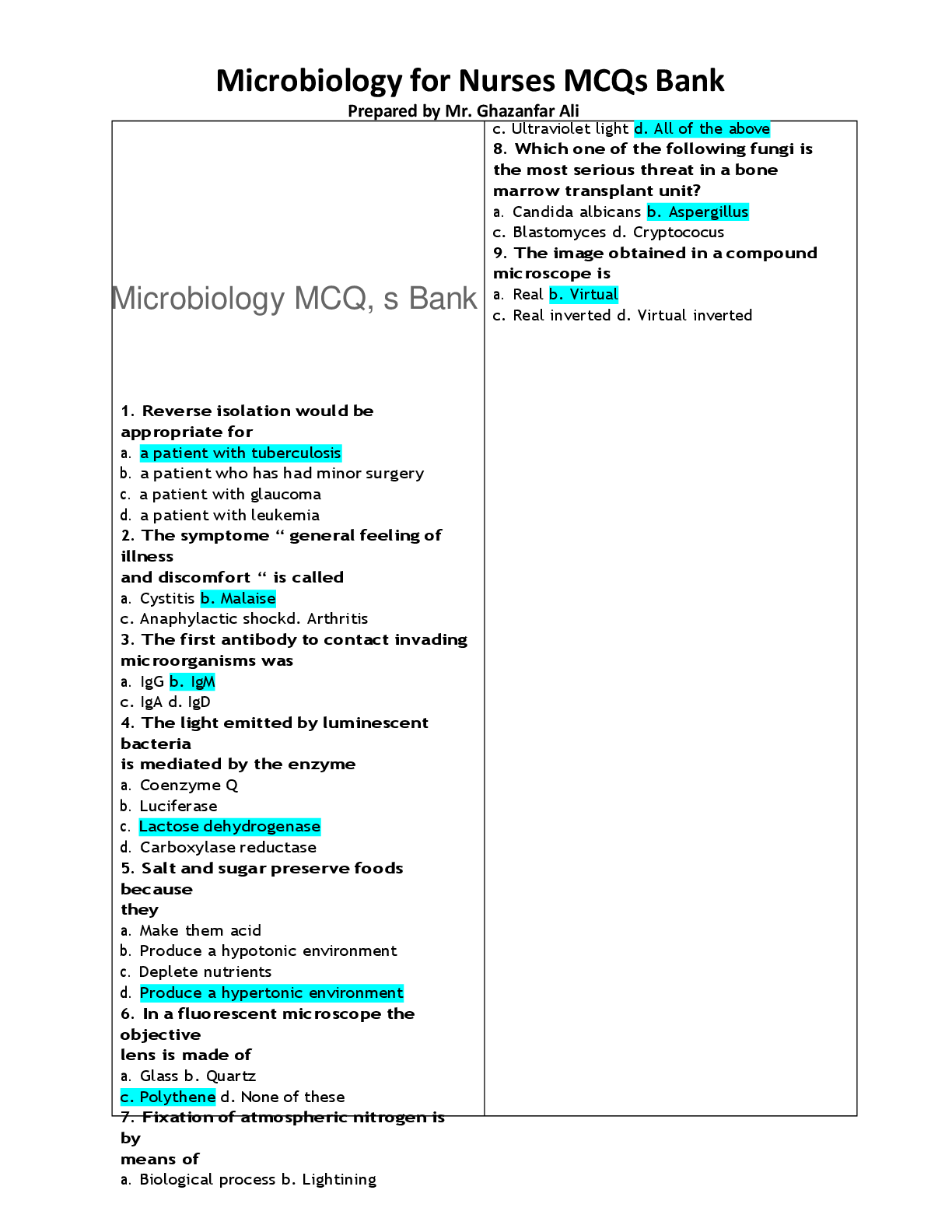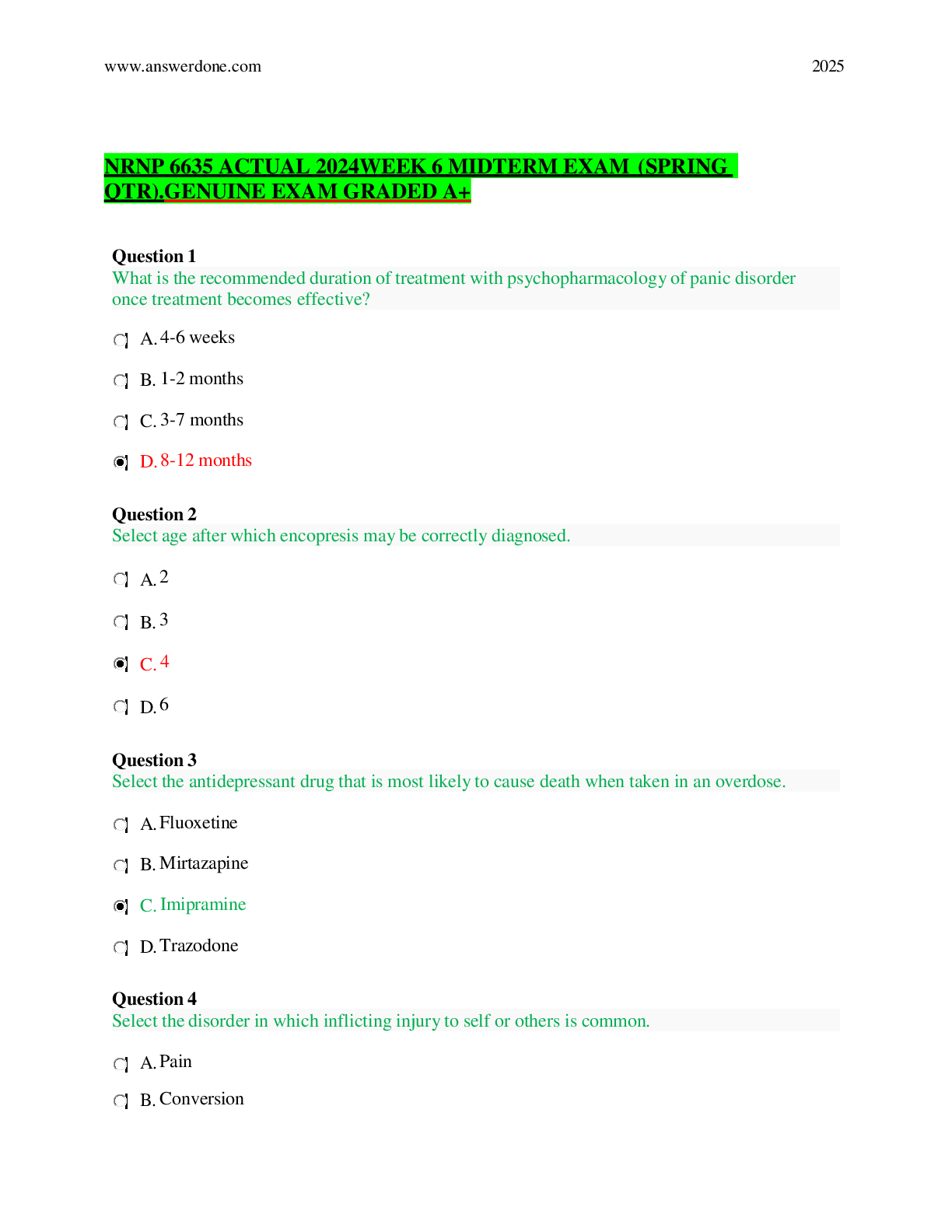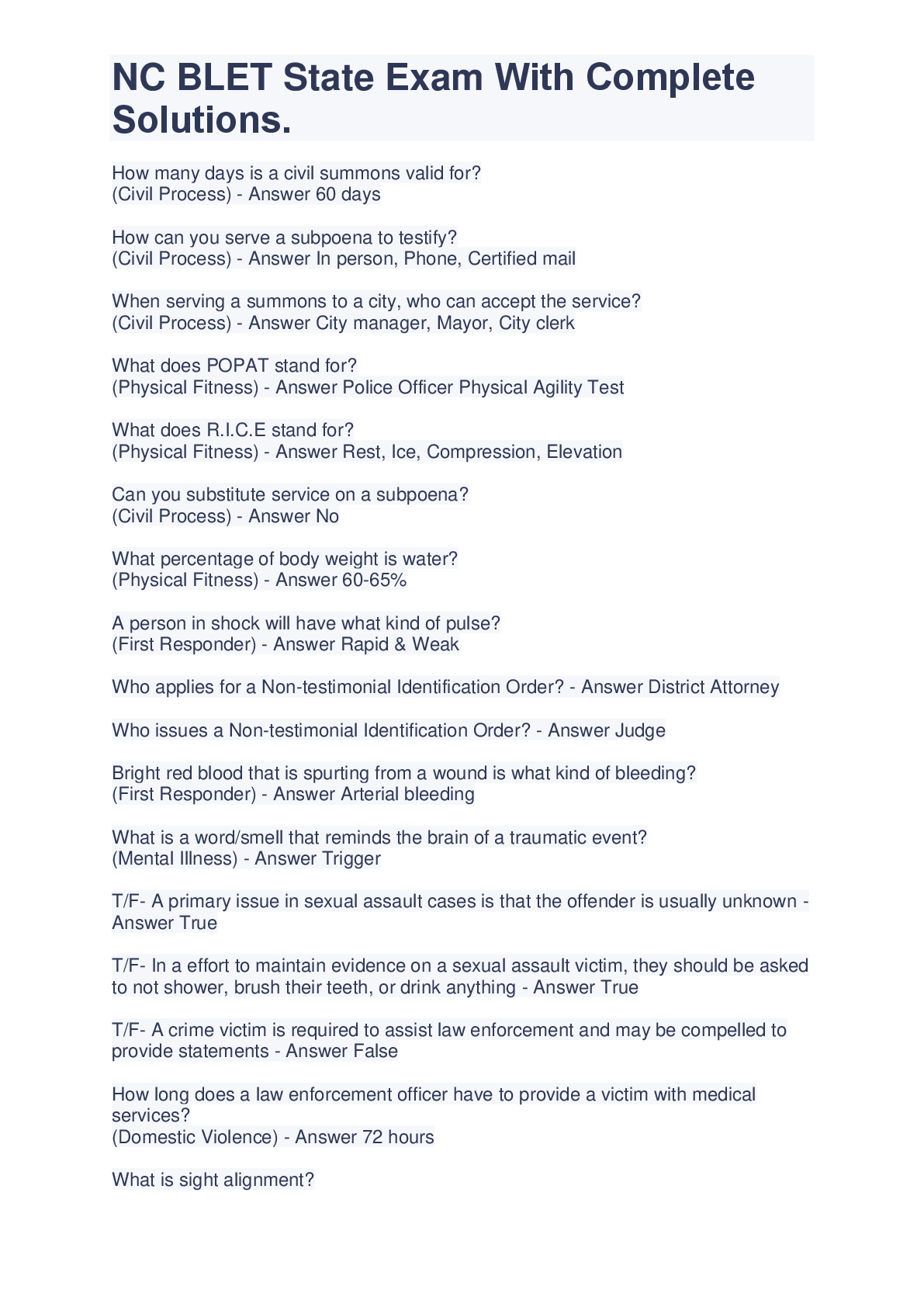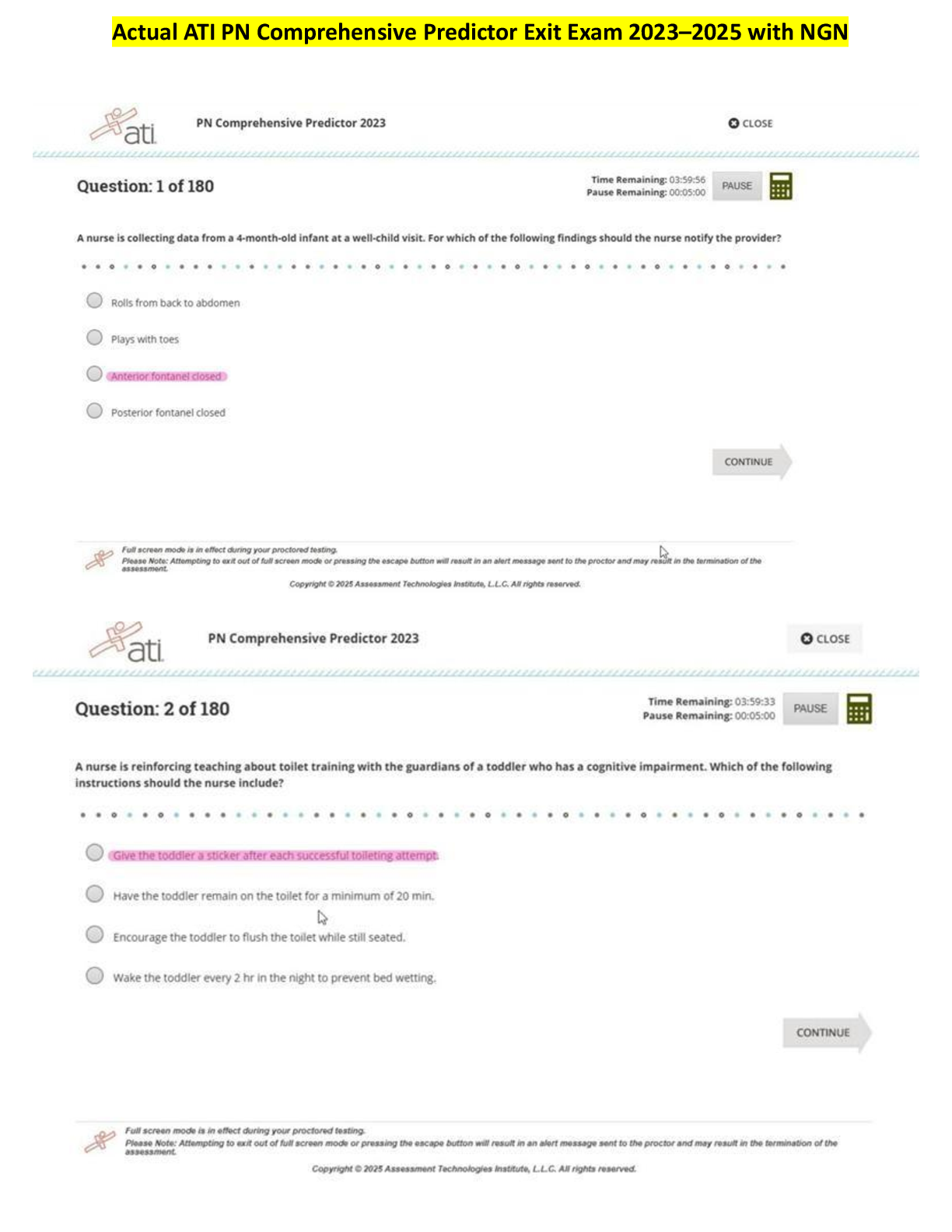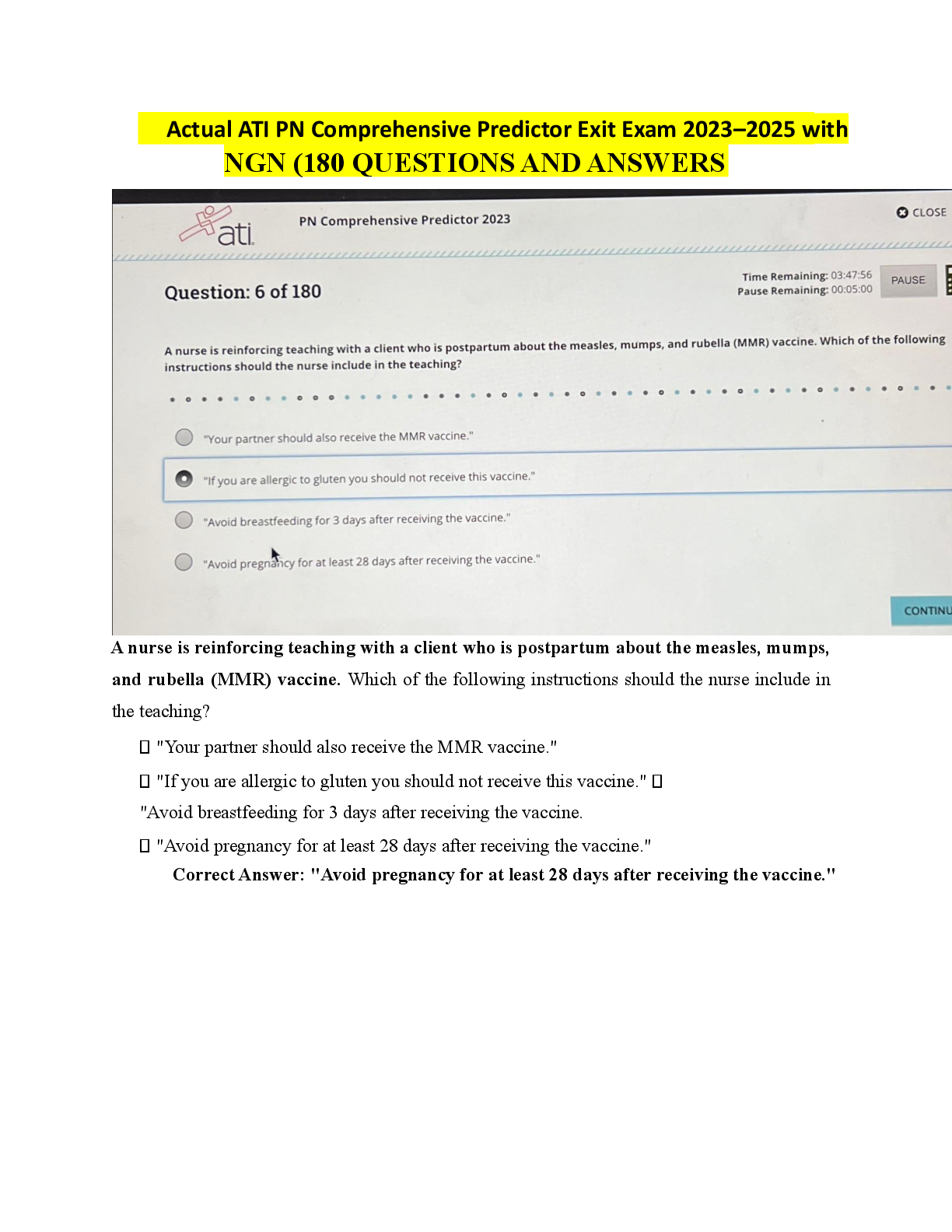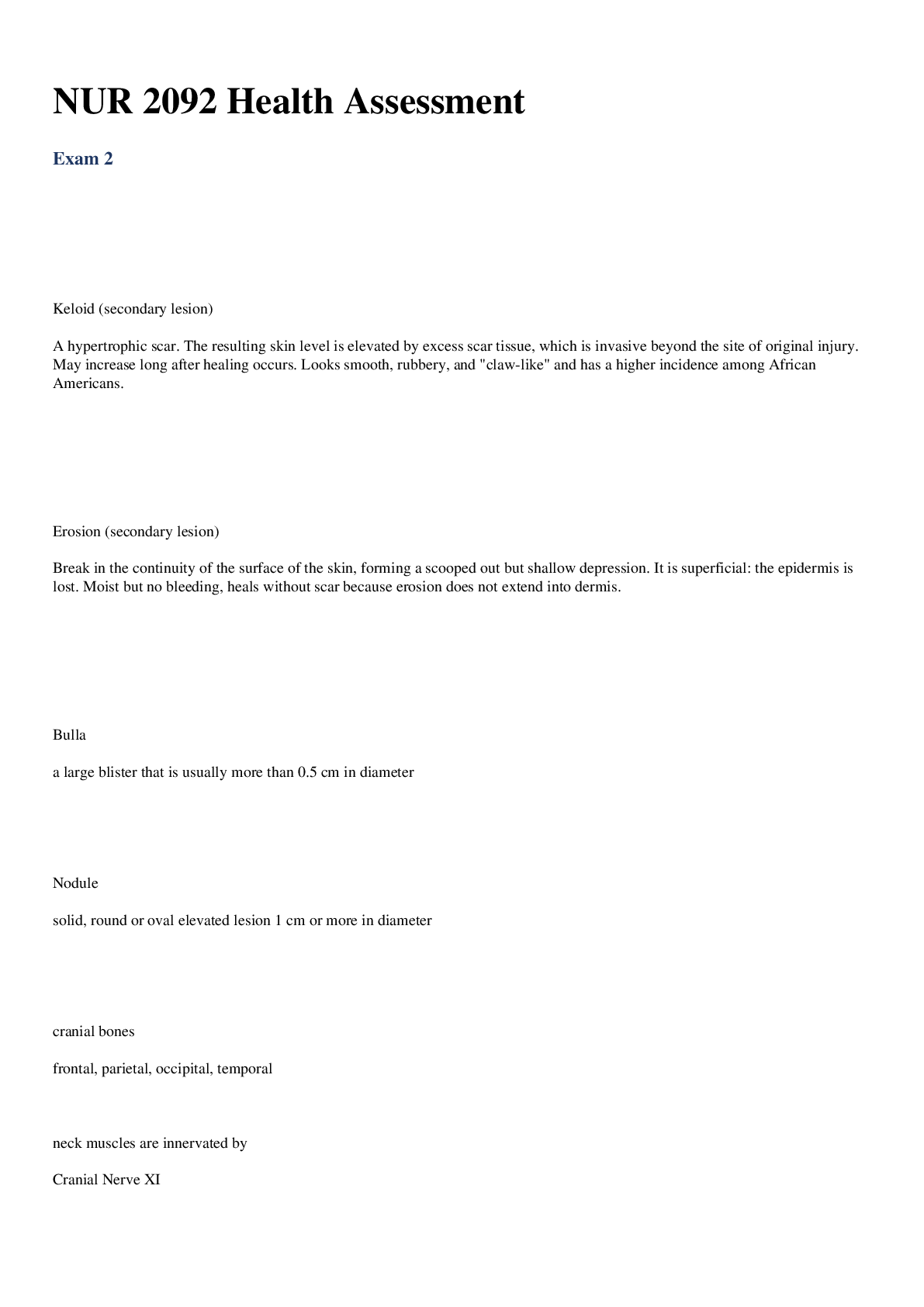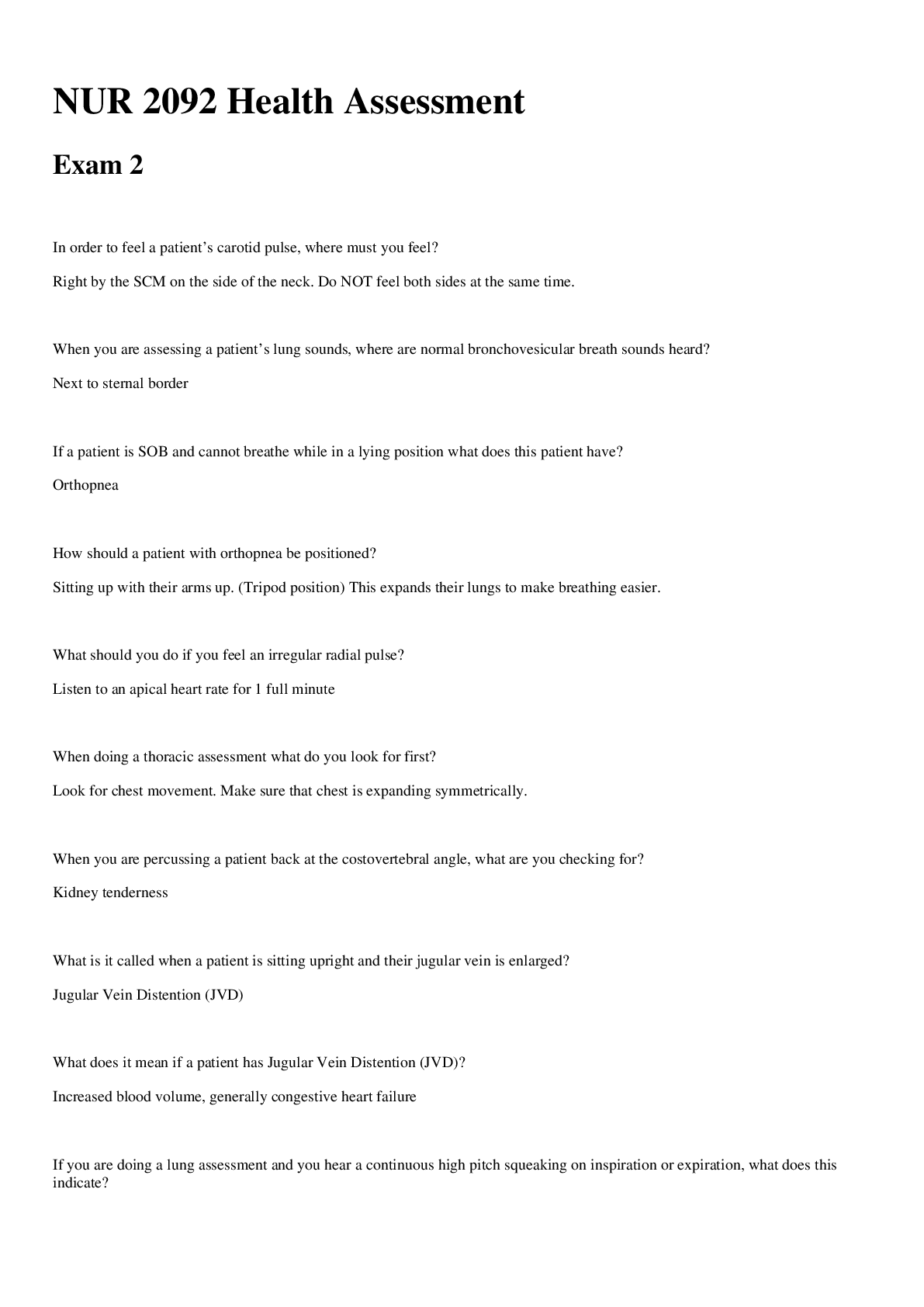Health Care > EXAM > Health Assessment quizzes new updated practice exam questions with correct answers complete solution (All)
Health Assessment quizzes new updated practice exam questions with correct answers complete solution.docx (Rasmussen collage)
Document Content and Description Below
Health Assessment quizzes new updated practice exam questions with correct answers complete solution.docx (Rasmussen collage) Quiz 1 1. After completing an initial assessment of a patient, the nurse ... has charted that his respirations are EUPEENIC and his pulse is 58 beats per minutes. These types of data would be: 2. The patient’s record, laboratory studies, objective data, and subjective data combine to form the: 3. When listening to a patient’s breath sounds, the nurse is unsure of a sound that is heard. The nurse’s next action should be to: 4. Expert nurses learn to attend to a pattern of assessment data and act without consciously labeling it. These responses are referred to as: 5. The nurse makes which adjustment in the physical environment to promote the success of an interview? 6. In an interview, the nurse may find it necessary to take notes to aid his or her memory later. Which statement is true regarding note-taking? 7. The nurse asks, “I would like to ask you some questions about your health and your usual daily activities so that we can better plan your stay here.” This question is found at the ___________. 8. When taking a history from a newly admitted patient, the nurse notices that he often pauses and expectantly looks at the nurse. What would be the nurse’s best response to this behavior? 9. A woman comes to the clinic to seek help with a substance abuse problem. She admits to using cocaine just before arriving. Which of these assessment findings would the nurse expect to find when examining the woman? 10. During a session on substance abuse, the nurse reviewing statistics with the class. For person’s age 12 years older, which illicit substance was most commonly used? 11. A woman who has just discovered that she is pregnant in the clinic for her first obstetric visit. She asks the nurse. “How many drinks a day is safe for my baby?” The Nurse’s best response is 12. As a mandatory reporter of elder abuse, which must be present before a nurse should notify the authorities? 13. During the home visit, the nurse notices that an older adult woman is caring for her bedridden husband. The woman states that this is her duty, she does the best she can, and her children come to help when they are in town. Her husband is unable to care for himself, and she appears thin, weak, and exhausted. The nurse notices that several of his prescription medication bottles are empty. This situation is best described by the term: 14. Which statement is best for the nurse to use when preparing to administer the Abuse Assessment Screen? 15. The nurse is using the Danger Assessment (DA) tool to evaluate the risk of homicide. Which of these statements best describe its use? Quiz 2 1. During a class on the aspect of culture, the nurse shares that culture has four basic characteristics. 2. During a seminar on cultural aspects of nursing, the nurse recognizes that the definition stating” the specific and distinct knowledge, beliefs, skills, and customs acquired by members of society” reflects which term? 3. The nurse is conducting a heritage assessment. Which question is most appropriate for this assessment? 4. When providing culturally competent care, nurses must incorporate cultural assessments into their health assessments. Which statement is most appropriate to use when initiating an assessment of cultural beliefs with an older American-Indian patient? 5. A female patient tells the nurse that she has had six pregnancies, with four live births at term and two spontaneous abortions. Her four children are still living. How would the nurse record this information? 6. During an assessment of a patient’s family history, the nurse constructs a genogram. Which statement best describes a genogram? 7. The nurse is preparing to do a functional assessment. Which statement best describes the purpose of a functional assessment? 8. The nurse is preparing to conduct a mental status examination. Which statement is true regarding the mental status examination? 9. The nurse is performing a mental status assessment on a 5 year old girl. Her parents are undergoing a bitter divorce and are worried about the effect it is having on their daughter. Which action or statement might lead the nurse to be concerned about the girl’s mental status? 10. A patient repeats, “I feel hot. Hot, cot, rot, tot, got. I’m a spot.” The nurse documents this as an illustration of: 11. A patient tells the nurse that his food simply does not have any taste anymore. The nurse’s best response would be: 12. A 21 year old woman has been on a low protein liquid diet for the past 2 months. She has had adequate intake of calories and appears well nourished. After further assessment, what would the nurse expect to find? 13. Which of these conditions is due to an inadequate intake of both protein and calories? 14. The nurse is asking questions about a patient’s health beliefs. Which questions are appropriate? Select all that apply 15. The nurse is assessing a patient who is admitted with possible delirium. Which if these are manifestations of delirium? Select all that apply Quiz 3 1. The performing a physical assessment, the first technique the nurse will always use is: 2. The nurse assessing a patient’s skin during an office visit. What part of the hand and technique should be used to best assess the patient’s skin temperature? 3. The nurse is teaching a class on basic assessment skills. Which of the statements is true regarding the stethoscope and its use? 4. Before auscultating the abdomen for the presence of bowel sounds on a patient, the nurse should: 5. The nurse is unable to palpate the right radial pulse on the patient. The best action would be to: 6. When measuring a patient’s weight, the nurse is aware of which of these guidelines? 7. The nurse is assessing an 80-year old male patient. Which assessment findings would be considered normal? 8. The nurse should measure rectal temperature in which of these patients? 9. The nurse knows that one advantage of the tympanic membrane thermometer (TMT) is that: 10. The nurse is examining a patient who is complaining of “feeling cold”. Which is a mechanism of heat loss in the body? 11. When evaluating a patient’s pain, the nurse knows that an example of acute pain would be: 12. A patient states that the pain medication is “not working” and rates his postoperative pain at a 10 on 1-to-10 scale. Which of these assessment findings indicates an acute pain response to poorly controlled pain? 13. The nurse is assessing a patient’s pain. The nurse knows that the most reliable indicator of pain would be the: 14. The nurse is reviewing the principles of pain. Which type of pain is due to an abnormal processing of the pain impulse through the peripheral of central nervous system? 15. When assessing the intensity of a patient’s pain which question by the nurse is appropriate? Quiz 4 1. The nurse educator is preparing an education module for the nursing staff on the dermis layer of skin. Which of these statements would be included in the module? The dermis: 2. The nurse is examining a patient who tells the nurse “I sure sweat a lot especially on my face and feet but it doesn’t have an odor.” The nurse knows that this condition could be related to: 3. The nurse is bathing an 80 year old man and notices that his skin is wrinkled, thin, lax, and dry. This finding would be related to which factor in older adults? 4. A mother brings her 2 month old daughter in for an examination and says, “My daughter rolled over against the wall, and now I noticed that she has this spot that is soft on the top of her head. Is something terribly wrong? The nurse best response would be 5. A patient’s laboratory data reveals an elevated thyroxine (T4) level. The nurse would proceed with an examination of the _______ gland. 6. The nurse is aware that the four areas in the body where the lymph nodes are accessible are the: 7. The nurse is reviewing cause of increased intraocular pressure. Which of these factors determines intraocular pressure? 8. The nurse is testing a patient’s visual accommodation, which refers to which action? 9. The nurse is preparing to assess the visual acuity if a 16 year old patient. How should the nurse proceed? 10. The nurse is examining a patient’s ear and notices cerumen in the external canal. Which of these statements about the cerumen is correct? 11. When examining the ear with an Otoscope, the nurse notes that the tympanic membrane should appear: 12. A patient with a middle ear infection asks the nurse, “what does the middle ear do?” The nurse responds by telling the patient that the middle ear functions to: 13. The tissue that connects the tongue to the floor of the mouth is the: 14. The salivary gland that is the largest and located in the cheek in front of the ear is the______ gland. 15. The nurse is assessing an 80 year old patient. Which of the findings would be expected for this patient? Quiz 5 1. When assessing a patient’s lungs, the nurse recalls that the left lung: 2. The primary muscles of respiration include the: 3. A 65 year old patient with a history of heart failure comes to the clinic with complaints of “being awakened from sleep with shortness of breath.” Which action by the nurse is the most appropriate? 4. The nurse is observing the auscultation technique of another nurse. The correct method to use when progressing from one auscultatory site on the thorax to another is _______ comparison. 5. During an assessment of an adult, the nurse has noted unequal chest expansions and recognizes that this occurs in which situation? 6. When listening to the heart sounds, the nurse knows the valve closures that can be heard best at the base of the heart are: 7. The component of the conduction system referred to as the pacemaker of the heart is the: 8. The electrical stimulus of the cardiac cycle follows which sequence? 9. The findings from an assessment of a 70 year old patient with swelling in his ankles includes jugular venous pulsation 5 cm above the sternal angle when the head of his bed is elevated 45 degrees. The nurse knows that this finding indicates: 10. In assessing a patient’s major risk factor for heart disease. Which would the nurse want to include when taking a history? 11. The nurse is reviewing the blood supply to the arm. The major artery supplying the arm is the ____ artery. 12. The nurse is preparing to assess the dorsalis pedis artery. Where is the correct location for palpation? 13. The nurse is reviewing the risk factors for venous disease. Which of the situations best describes a person at highest risk for the development of venous disease? 14. A 67 year old patient states that he recently began to have pain in his left calf when climbing the 10 stair to his apartment. This pain is relieved by sitting for approximately 2 minutes; then he is able to resume his activities. The nurse interprets that this patient is most likely experiencing: 15. The nurse is performing on an adult. The adult’s vital signs are normal, and capillary refill time is 5 seconds. What should the nurse do next? Quiz 6 1. The nurse is percussing the seventh right intercostal space at the midclavicular line over the liver. Which sound should the nurse expect to hear? 2. An older patient has been diagnosed with pernicious anemia. The nurse knows that this condition could be related to: 3. Which of these percussion findings would the nurse expect to find in a patient with a large amount of ascites? 4. The nurse is reviewing statics for lactose intolerance is higher in adult ethics group? 5. The mother of a 10 year old boy asks the nurse to discuss the recognition of puberty. The nurse should reply by saying: 6. A 15 year old boy is seen in the clinic for complaints of “dull pain and pulling” in the scrotal area. On examination, the nurse palpates a soft, irregular mass posterior to and above the testis on the left. This mass collapses when the patient is supine and refills when he is upright. This description is consistent with: 7. Which statement concerning the anal canal is true? The anal canal: 8. While performing a rectal examination, the nurse notices a firm, irregular shaped mass. What should the nurse do next? 9. During a health history a 22 year old woman asks, “Can I get that vaccine for human papilloma virus (HPV)? I have genital warts and I’d like them to go away! What is the nurse’s best response? 10. During an examination, the nurse observes a female patient’s vestibule and expects to see the: 11. The uterus is usually positioned tilting forward and superior to the bladder. This position is known as 12. An 11 year old girl is in the clinic for a sports physical examination. The nurse notices that she has begun to develop breasts, and during the conversation the girl reveals that she is worried about her development. The nurse should use which of these techniques to best assist the young girl in understanding the expected sequence for development? The nurse should: 13. During the interview with a female patient, the nurse gathers data that indicates the patient is perimenopausal. Which of these statements made by this patient leads to this conclusion? 14. The nurse suspects that a patient as appendicitis. Which of these procedures are appropriate for use when assessing for appendicitis or a perforated appendix? Select all that apply: 15. A 16 year old boy is brought to the clinic for problem that he refused to let his mother see. The nurse examines him and finds that he has scrotal swelling on the left side. He had the mumps the previous week, and the nurse suspects the he has orchitic. Which of the following assessment findings support this diagnosis? Select all that apply: [Show More]
Last updated: 3 years ago
Preview 1 out of 13 pages

Buy this document to get the full access instantly
Instant Download Access after purchase
Buy NowInstant download
We Accept:

Reviews( 0 )
$15.50
Can't find what you want? Try our AI powered Search
Document information
Connected school, study & course
About the document
Uploaded On
Jan 28, 2021
Number of pages
13
Written in
All
Additional information
This document has been written for:
Uploaded
Jan 28, 2021
Downloads
0
Views
203


.png)



